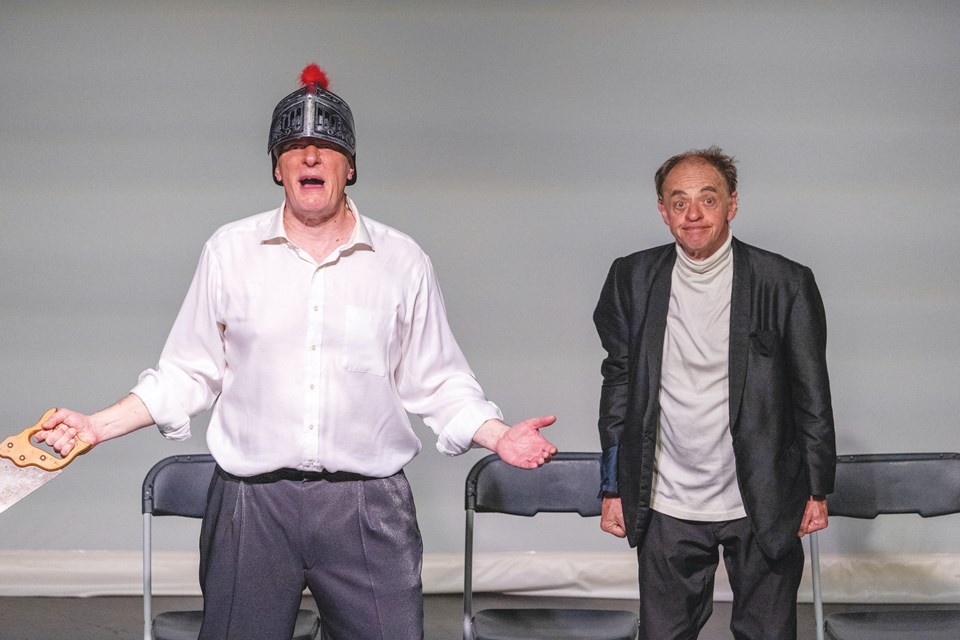A partnership forged during the Sechelt Arts Festival delivered a theatrical tour de force that last month united paper puppets and flourishes of flamenco while foreshadowing further evolution for the production.
Time and Shadows, which played at the Heritage Playhouse in Gibsons on March 23, was a full-length performance developed by Gerardo Avila and Steven Schwabl. Schwabl is a professional actor who first worked with Avila in 2018 when Avila — a career clown, mime and magician with a master’s degree in Hispanic and Italian studies — organized the Satio Circus.
Satio was a grassroots collaboration with the shíshálh Nation that used a range of circus arts to tell stories. “It was one of the most extraordinary shows that I’ve ever been a part of,” said Schwabl. “There was this mix of clowns and an innocence that was trying to save the world against this evil force. It was such a wonderful place to play. That’s what I was trying to find again.”
Avila and Schwabl reunited at last year’s Sechelt Arts Festival, where they masterminded a folkloric shadow play (set to music by the band Caravan Paradiso) exploring intercultural exchanges and colonialism in Latin America.
“We got all these people together and we produced it, based on a Mexican story about La Malinche,” said Avila. La Malinche, or Marina, was a woman of the Nahua Nation who acted as an interpreter for Spanish conquistador Hernán Cortés. “Some people call her a traitor; today they are thinking she’s a victim. She was a victim of circumstance and a heroine for many people. So that was the story I wanted to tell.”
Using remaining funds from a provincial arts grant, the pair developed a vision for Time and Shadows. The shows would eventually blend original sound design by Hans Kuhlman, shadow puppetry by Hazel Bell-Koski and Dana Wilson, solo instrumentals by violinist Karen Foster, and dance and vocals by flamenco artist La Zarmari. Schwabl reprised his former role as ringmaster; Alvira portrayed his comic companion and sometime foil, demonstrating deadpan clowning technique that he refined during a four-year residency with Cirque du Soleil.
“In the old days, in the traditional circus language, it was the straight, the white, the red, and the hobo clowns,” said Avila. “Now they don’t differentiate as they used to.” In Time and Shadows, Avila hewed to the red (or Auguste) school of physical clowning, amusing audiences as he destroyed and restored a newspaper (the Coast Reporter, in a nod to the show’s homegrown origins), demonstrated mock feats of strength, and performed a one-note horn solo as Schwabl accompanied with the eerie wail of a bowed saw.
“I love the moments where I’m confused by what’s going on,” said Schwabl. “I’m just trying to figure out what in the world he’s doing but I’m still trying to stay present because my number one goal is always to have a professional show.”
The plot itself careened from the Mesozoic Era into the distant future, transported by a hallucinogenic time machine that doubled as a puppet theatre. While in character, Avila and Schwabl acknowledged their status as performers and occasionally toyed with their own projected shadows. (Fittingly, Don Quixote and his windmill nemesis made appearances.) The story followed a rollicking course into metatheatre. The two artists wrestle with existential enigmas, meanwhile striving for their errant act to reach an ultimate apotheosis.
Avila plans on reprising elements of the show both on the Sunshine Coast and at Vancouver festivals. “This show is going to have a lot of ramifications,” he said. “Theatre is like that. The show dies tonight; it is a moment, which is magic. Then you take pieces of it and everybody gets ideas for the next one.”



